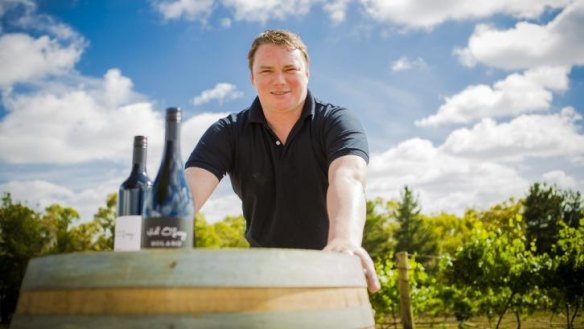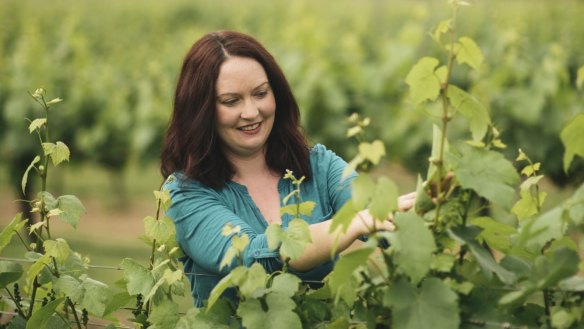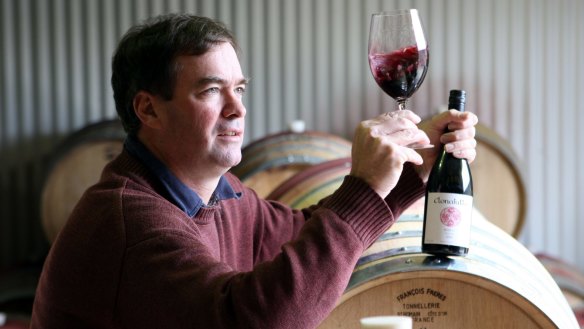Canberra wine region: 2015 tipped to be one of the best vintages in decades
Some of the district's first 2015 rieslings are already proving to be the best since 1971. Winemakers are hoping their shirazes, other reds and whites will follow suit. Chris Shanahan reflects on a year which could become the best yet. He also reveals an exciting maverick attitude towards growing new varieties.

- Canberra District's top 10 white wines for 2015
- Canberra District's top 10 red wines for 2015
- Canberra's beer scene: 2015 one crafty year
By the new year in 2015, Canberra's widely scattered vineyards, ranging in altitude from between 550 metres and 860 metres, held big, healthy crops. Vignerons crossed their fingers, hoping for the weather to hold. And it did, despite rain, warm weather and subsequent threat of bunch rot for a brief period in January.
From budburst in spring 2014 to harvest in autumn, benign conditions produced one of the earliest, biggest, compressed and potentially most beautiful grape harvests the district had seen since 1971 – the year John Kirk and Edgar Riek planted their vineyards at Murrumbateman and Lake George.
Murrumbateman winemaker Ken Helm declared: "If we get a better vintage than this, I'll be very, very surprised". At Hall, Alan Pankhurst of rated the season "a bit better than 2013" – a vintage widely lauded as one of the greatest ever.
Despite good yields and high fruit quality, the vintage became something of an ordeal when everything ripened at once. Mid vintage Lerida Estate's Jim Lumbers said: "We've had very late nights, our capacity has been stretched but coping. We've been picking and processing every day with no breaks.".
As we approach the year's end, Canberra's unoaked 2015 whites, led by riesling, are bottled and available, while chardonnay and most reds remain in barrel, to be blended and bottled next year. Only then will we have the full measure of the vintage.
The finished rieslings, however, support the winemakers' early optimism. The earliest releases rolled onto the tasting bench during the depths of our cold winter, just four months after harvest. While Canberra riesling can be shy or austere at this stage, some already tasted terrific – notably those that a few months later won gold medals at the 2015 Canberra Regional Wine Show: Clonakilla, Ravensworth, Helm Classic and Helm Semi Dry.
As the weather warmed up, these and other rieslings began to reveal greater aroma and flavour – a widely known quirk of fine young riesling. In early October, Stephanie Helm's Vintner's Daughter caught our attention. And in November we drooled over Nick O'Leary's two amazing rieslings – a mouth-watering beauty from Lake George and Murrumbateman ($25) and the more demure, slow-evolving, intense White Rocks ($37) from the original Westering vineyard, Lake George.
Vintner's Daughter deserves special mention as it topped all the riesling in the Winewise Small Vignerons Awards, dropped back to silver for the regional show, then earned gold and trophy as the best Canberra riesling at the International Riesling Challenge.

Unfortunately, Canberra's regional wine show, judged in September, precedes the great flourishing of our new-vintage rieslings by a couple of months. It therefore misses seeing our great white specialty at its best. Even so, three quarters of the 31 2015-vintage rieslings exhibited this year won medals, including five golds and five silvers.
White drinkers can't go wrong stocking up on the 2015 rieslings. The wines can only get better over the coming months. And many should evolve deliciously for years.
Canberra's other specialty, shiraz, remains unassailable in both quality and quantity across most of the district. We must wait until 2016 for the 2015 wines, and most of the outstanding 2013s sold out long ago. However, one of the best, Collector Reserve Shiraz 2013, remains on collectorwines.com.au for $58 at the time of writing. The beat every other shiraz in this year's regional wine show, winning the top gold medal in its class and three trophies: best Canberra shiraz, best shiraz and best red.
While the 2013 shirazes upstage the 2014s to some extent, the vintage produced many beautiful wines. Of 35 entered in the regional wine show, two thirds won medals, with golds medals to McWilliams Appellation Series Hilltops Shiraz 2014, Collector Reserve 2014 (a great follow up to the trophy winning 2013), Nick O'Leary 2014 (NSW wine of the year), and Clonakilla O'Riada 2014. The latter two and Collector Reserve 2013 feature in my top 10 reds.
But there's no reason to limit drinking to the current gold medal shirazes. There's a spectrum of good Canberra shirazes covering many hues of the Canberra medium-bodied, spicy style.
The excellence of our shiraz and riesling anoint Canberra with a special status among Australian wine regions. But our vignerons make good wines, if not regional specialties, across the whole gamut of mainstream varieties. These are commercially important to their producers and enjoy wide appeal among drinkers.
Will there be a next big thing after shiraz and riesling? While there's nothing to challenge either yet, some of the so-called "alternative" varieties work well both in Canberra and surrounding districts.
Data collated from the Australian and New Zealand Wine Industry Directory, phone calls, and an email poll of local vignerons by the Canberra District Wine Industry Association, reveals 23 Canberra wineries processing 14 alternative red varieties, and 17 wineries working with five alternative whites.
Some of these are already well known. Rhone white variety, viognier, plays a support role in Canberra benchmark Clonakilla Shiraz Viognier and a string of other similar red blends.

It's the most widely used of Canberra's "alternative" varieties (15 vignerons) and is offered as a straight varietal by Clonakilla (wooded and unwooded versions), Dionysus, Jeir Creek, Kardinia Wines and Lark Hill. The variety also appears in white blends alongside the other Rhone varieties, marsanne and roussanne.
A small planting of Austria's gruner veltliner at Lark Hill, high up on the Lake George Escarpment, settled well into this cool site and makes a delicious and distinctive dry white. It's another beacon for Canberra.
At Hall, Alan Pankhurst recently grafted arneis, a Piedmont white variety, onto chainsaw-pruned sauvignon blanc vines. He expects to produce wine from it within the next vintage or two.
Canberra winemakers currently work with a broader palate of alternative reds than whites. In our survey, we discovered graciano, tempranillo, sangiovese, gamay, nebbiolo, touriga nacional, colourino, mammolo, canaiolo nero, mondeuse, aglianico, nero d'avola and cinsault – some from Canberra, some from neighbouring districts.
Italy's sangiovese and Spain's tempranillo are the most widely used of these by Canberra winemakers. In our survey, we found 12 vignerons working with sangiovese and eight with tempranillo.
Tempranillo perhaps enjoys the strongest profile of the two, thanks to its generous, ripe, mid-palate fruit, albeit tempered by firm, savoury tannins. An annual "TempraNeo" promotion by six Australian producers, including Canberra's Mount Majura, is also lifting the variety's profile. Australia wide, 340 winemakers use it.
Sangiovese offers a generally leaner, more savoury style than tempranillo, although it varies widely among winemakers. This reflects clones, growing conditions, winemaking style and, in some instance, the inclusion of other varieties in the blend.
At Mount Majura, graciano stars on its own – and also supports the popular and excellent tempranillo-shiraz-graciano blend.
Piedmont's nebbiolo, too, shows promise in the neighbouring Hilltops region. Brian Freeman's, made at his Hilltops vineyard, has a slight edge to my palate, over Bryan Martin's Ravensworth, made in Canberra from Hilltops fruit.
Between established specialties, shiraz and riesling, other mainstream varieties, and a growing number of niche varieties, the quality and diversity of Canberra wines continues to grow. We enjoyed better Canberra wine this year than ever before. That choice and quality can only grow, within vintage vagaries, over the years ahead.
And 2015 ended on a happy note. Members of the Canberra District Vignerons Association marked the 41st anniversary of its first meeting with a November 20 lunch at Podfood. Industry pioneers Ken Helm, John Kirk and Edgar Riek attended the lunch – and that inaugural meeting on November 19, 1974. Forty-one years on the district flourishes more than they could have imagined.